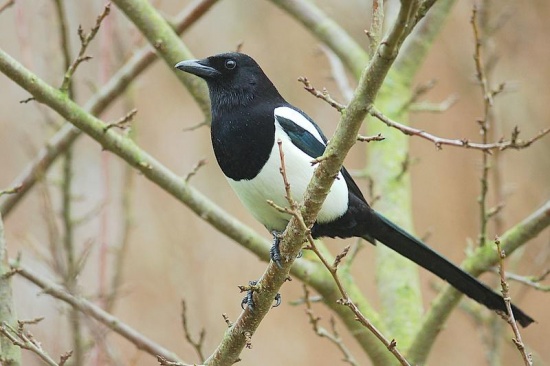Alternative Names: Common Magpie; Pied Magpie
- Pica pica
Formerly included: Asir Magpie; Oriental Magpie; Black-rumped Magpie; and Maghreb Magpie
Identification
Length 46–50 cm (18-19¾ in); weight 187-268 g (male), 161-240 g (female)
- Black head, neck, breast and back
- Prominent white side patches and belly
- Wings and tail, whilst looking black in certain lights, are actually blue-green and purple
- Very long tail, diamond-shaped when spread out
Sexes are similar. Juveniles are duller than adults.
Distribution
Found across most of northern Eurasia from Europe to the Russian Far East and south to Asia Minor and northwest India. Birds ranging in Africa, Arabia and Southern Asia now considered to belong to other species. Widespread and common in most of its range.
Taxonomy
This species was formerly considered conspecific with Black-billed Magpie P. hudsonia.
Subspecies
Six subspecies are recognised[1]:
- P. p. melanotos:
- P. p. pica:
- Europe, from the British Isles, France, and southern Scandinavia to eastern Europe and Asia Minor
- P. p. fennorum:
- Northern Scandinavia and western Russia
- P. p. bactriana:
- P. p. leucoptera:
- Southern Transbaicalia to eastern Mongolia and Altai Mountains
- P. p. camtschatica (Kamchatka Magpie):
- Northern shores of Sea of Okhotsk to Kamchatka Peninsula
- Northern shores of Sea of Okhotsk to Kamchatka Peninsula
P. p. galliae of Western Europe to Balkans is a junior synonym of P. p. pica and no longer recognized.[1]
P. p. hemileucoptera of Western and southern Siberia to Outer Mongolia is considered to be a junior synonym of P. p. bactriana and no longer recognized.[1]
The following former subspecies have been split into full species[1]
- P. p. mauretanica Maghreb Magpie
- P. p. asirensis Asir Magpie
- P. p. bottanensis Black-rumped Magpie
- P. p. serica Oriental Magpie
Habitat
Farmland and open country. Also town gardens and parks.
Behaviour
Walks and will hop sideways.
Flight
Quick, with deep, fast, even wing beats. Short glides.
Diet
Omnivorous. Feeds mainly on invertebrates, small mammals, lizards, frogs, bird eggs, nestlings and carrion. Often caches food.
Breeding
Builds a domed nest in tall trees, or hedgerows which often contains shiny objects
Vocalisation
Harsh "chack, chack, chack".
References
- Clements, J. F., T. S. Schulenberg, M. J. Iliff, D. Roberson, T. A. Fredericks, B. L. Sullivan, and C. L. Wood. 2018. The eBird/Clements checklist of birds of the world: v2018. Downloaded from http://www.birds.cornell.edu/clementschecklist/download/
- Gill, F & D Donsker (Eds). 2018. IOC World Bird List (v8.2). doi : 10.14344/IOC.ML.8.2. Available at http://www.worldbirdnames.org/
- Del Hoyo, J, A Elliott, and D Christie, eds. 2009. Handbook of the Birds of the World. Volume 14: Bush-shrikes to Old World Sparrows. Barcelona: Lynx Edicions. ISBN 978-8496553507
- Birdwatchers Pocket Guide ISBN 1-85732-804-3
- Collins Pocket Guide to British Birds 1966
- Collins Field Guide 5th Edition
- Madge, S., Christie, D.A. & Kirwan, G.M. (2018). Eurasian Magpie (Pica pica). In: del Hoyo, J., Elliott, A., Sargatal, J., Christie, D.A. & de Juana, E. (eds.). Handbook of the Birds of the World Alive. Lynx Edicions, Barcelona. (retrieved from https://www.hbw.com/node/60753 on 17 August 2018).
- Song, G., Zhang, R., Alström, P., Irestedt, M., Cai, T., Qu, Y., Ericson, P.G.P., Fjeldså, J. & Lei, F. (2018) Complete taxon sampling of the avian genus Pica (magpies) reveals ancient relictual populations and synchronous Late-Pleistocene demographic expansion across the Northern Hemisphere. J. Avian Biol.49(2): https://doi.org/10.1111/jav.01612.
Recommended Citation
- BirdForum Opus contributors. (2025) Eurasian Magpie. In: BirdForum, the forum for wild birds and birding. Retrieved 27 April 2025 from https://www.birdforum.net/opus/Eurasian_Magpie
External Links
GSearch checked for 2020 platform.







